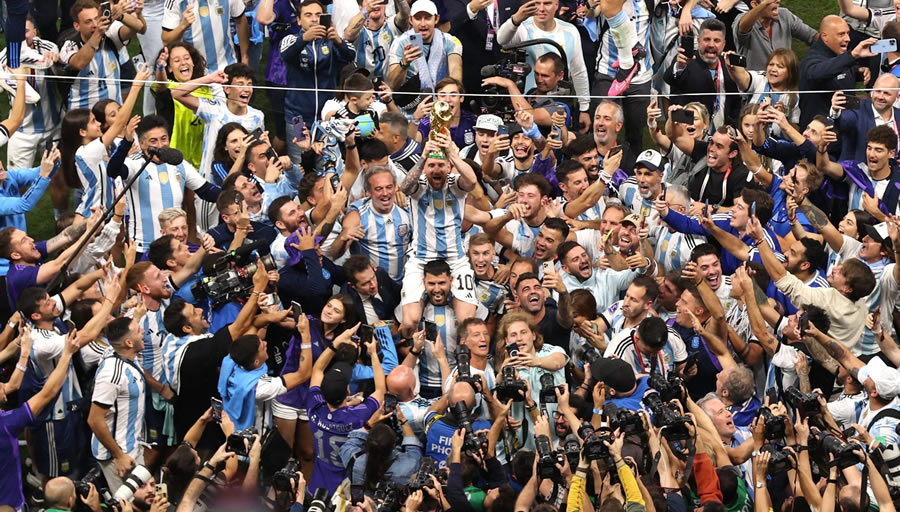Vertical videos are no longer a format exclusive to social networks. Today they are one of the most interesting disruptions in the sports television industry.

Vertical videos are a format that is far from reaching its ceiling among the different content generators in the sports industry. Associated with social networks and content creation platforms from a smartphone and for a smartphone, the truth is that mainstream media and organizations also contemplate it for their broadcasts or for the scrolling of their audiovisual pieces within their applications. In short, vertical video is not a format exclusive to social networks, even if that was its original starting point.
We will deal with the mainstream and the use given by broadcasters to vertical video, perhaps one of the most interesting disruptions in the television industry linked to sports in recent times.
The generation of vertical video content is already the main star of social networks. The British consulting firm Redtorch publishes an annual report with data on engagement and audience growth in social networks of the International Sports Federations. A survey of well-known organizations such as FIFA, FIBA (basketball), UCI (cycling), World Athletics (athletics), World Rugby, FIVB (volleyball) ITF (tennis), among a list of 42 federations. One rules global soccer and the others have their World Cups and raise their profile during the Olympic Games.
The most salient data from the report is based on the increase in vertical video-based posts:
+118 percent increase in vertical video posts across all platforms – TikTok, Instagram, Facebook, X and YouTube.
+818 percent growth in Facebook reels.
+777 percent increase in YouTube shorts.
+104 percent growth on TikTok.
Sports on Social 2024, as the report is called, claims that YouTube Shorts are rapidly gaining popularity, although classic videos still hold the majority on the platform. Reels dominate on Instagram, accounting for more than half of all posts. Reels on Facebook generated 18 percent more engagement than traditional videos on the platform.
TikTok may be seen as the platform that grew the least over 2022, but that perspective is misleading: its raison d’être is vertical video. It always was that. But what stands out is the increase in sports videos lasting more than a minute: a growth of more than +196%. The data suggests that viewers are looking for a deeper experience and narrative experiences on the platform that don’t rely on frenetic scrolling. What seems to be of interest is the vertical format, enriched by audios and songs, filters and other props. It’s not the short only. It’s the vertical.
This report, which reviews how international sports federations connect with their audiences, requires a clarification: these organizations are the tail end of how fans connect with their interests in sports. Athletes are the biggest conveners. Then come the clubs. Behind them come the leagues that organize the competitions and at the end of it all the federations that have always had as their central task the regulation, control and organization of a sport. In other words, the least sexy part. Now these structures are also obliged to communicate and seek out their followers. FIFA understood this a long time ago. Let’s take an example.

FIFA introduced in Qatar 2022 one of the most interesting innovations in the history of the transmission of World Cups and that was not properly highlighted: the generation of videos in vertical format, but not as additional pieces for social networks but integrated into the feeds received by broadcasters.
The digital division of HBS – FIFA’s host broadcaster from Korea / Japan 2022 – set up a structure of more than 90 people dedicated to the creation of digital content for the image menu of the official World Cup broadcasters. From that crew there were two reporters with smartphones in each stadium who aimed to create content in a natural way and with a homemade texture. These videos were in vertical format and had to comply with two premises:
Tell an “almost live” story that could have been recorded minutes before and could be integrated into the broadcasters’ feed.
The images had to look as if a friend of ours had “sneaked” onto the playing field and sent us a capture of what he was seeing and living at that moment. In that exact limit between high quality vertical video and fan spirit.
Bundesliga is one of the most innovative soccer leagues. Nearly one million users experienced the German Supercup in portrait format. DFL, the Bundesliga’s innovation, business and asset development structure, had a pilot case in December 2021 with a German Supercup match.
DFL went with this content to the TikTok accounts of two rights licensees: Ran Sport in Germany and OneFootball for the Brazilian territory. Sky Sports also made the 9:16 broadcast available to its users within its app for the UK and Ireland. Ran Sport registered 450 thousand unique users, while OneFootball had 500 thousand.
DFL generated the broadcast with 9 cameras and a dedicated editor to achieve the 9:16 format. It was not an adaptation of the original broadcasts. It is a concept that takes risks and thinks more about the user than about the historical continuity of the traditional way of broadcasting soccer. In April 2022, LaLiga also experimented with vertical format matches. For now, the issue remains there.
Is watching a soccer, tennis or rugby match in portrait format a superior instance? The industry seems to indicate that it is not, and so do habits, but vertical video is already installed as a resource that is incorporated to the transmissions we know. A look designed for consumption on smartphones and social networks to add television entertainment.
Paris 2024, next July, will be a new platform to carefully follow the resources that vertical video has to satisfy a new generation of fans who learned to “scroll” as one of their early skills.